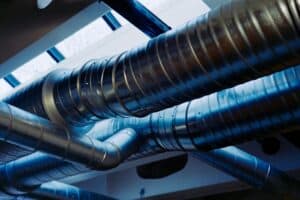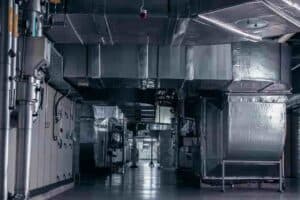Laundry duct cleaning isn’t just a box-ticking exercise—it’s a vital safety and compliance requirement that protects lives, property, and business operations. At Plasma Clean Air, we often work with clients who are surprised to learn that their laundry extract systems fall under a medium fire risk category and require regular, documented cleaning. But with good reason.
Lint and debris from dryers are not only highly flammable, but also easily accumulated in poorly maintained systems. Combined with the heat generated during dryer operation, this creates a very real fire risk. That’s why regulatory bodies have clear guidance on how often these systems should be inspected and cleaned—and why failure to comply can result in more than just a slap on the wrist.
Let’s explore why laundry duct cleaning is so important, what’s required by law, and how to stay compliant and safe.
Key Regulations and Standards
Laundry extract systems are subject to multiple layers of regulation, all designed to reduce fire risk and ensure safe working environments.
TR19® Air – The Industry Benchmark
Published by BESA (Building Engineering Services Association), TR19® Air provides best-practice guidance on the hygiene of ventilation systems, including laundry ducts. It classifies laundry systems as medium risk, which means regular cleaning is a requirement—not a recommendation.
The Regulatory Reform (Fire Safety) Order 2005
This UK legislation places the onus on a “responsible person”—typically the business owner or facilities manager—to carry out fire risk assessments and take preventative action, including maintaining extract systems.
The Health and Safety at Work Act 1974
Employers are legally obligated to ensure a safe and healthy environment. This includes maintaining clean air systems to prevent fire hazards and protect indoor air quality.
Why is Laundry Duct Cleaning So Important?
1. Fire Safety
The most pressing concern is fire risk. Lint is incredibly flammable, and dryer ducts create the perfect conditions for ignition—warmth, dryness, and a constant flow of air. Regular cleaning helps prevent dangerous build-ups and reduces the risk of catastrophic fires.
2. Indoor Air Quality
Dust, allergens, and chemical residues from cleaning agents can circulate through dirty ductwork. Keeping ducts clean helps maintain healthy indoor air, which is essential for both staff and customers, particularly in care homes, hotels, and hospitals.
3. Energy Efficiency
Clogged ducts make dryers work harder, increasing energy consumption and shortening the lifespan of the equipment. Clean ducts ensure efficient operation and reduced running costs.
4. Legal Compliance
Failure to meet TR19® Air standards or fire safety regulations can lead to fines, enforcement action, and reputational damage. In the event of a fire, non-compliance can also invalidate insurance cover and lead to personal liability for the responsible person.
5. Insurance Validation
Many insurers now require proof of regular duct cleaning. Without it, you could find yourself uninsured in the event of an incident.
What Does Laundry Duct Cleaning Involve?
1. Inspection
Regular inspections are essential to determine the condition of the ductwork. This may involve visual checks, borescopes, or even wet film thickness (WFT) testing to identify lint accumulation and airflow obstructions.
2. Cleaning Methods
Specialist techniques such as manual scraping, air-washing, rotary brush cleaning, and industrial vacuuming are used to remove lint, dust, and other residues. In some cases, chemical cleaning may also be required.
3. Post-Cleaning Verification
After cleaning, the system is checked to ensure it meets cleanliness and performance standards. Documentation is provided for your records—and for any insurers or regulatory bodies.
How Often Should Laundry Ducts Be Cleaned?
TR19® Air recommends that cleaning frequency should be determined by the system’s workload:
- Heavy use (e.g. commercial laundries, hospitals): Every 3–6 months
- Moderate use (e.g. hotels, care homes): Every 6–12 months
- Light use (e.g. small B&Bs): Every 12 months
In addition, the Fire Safety Order requires annual inspections and maintenance as a minimum.
It’s worth noting that usage patterns can vary, so regular inspection is the best way to ensure you’re not letting lint build up to dangerous levels.
Who’s Responsible?
Under the Fire Safety Order, there must be a “responsible person” who oversees compliance. This is often the business owner, facilities manager, or site supervisor. They are accountable for ensuring that regular inspections and cleaning take place, and that suitable documentation is kept on file.
However, the work itself should always be carried out by qualified professionals with appropriate training, equipment, and certification. Contractors who are BESA members and who work in accordance with TR19® Air standards provide peace of mind and regulatory protection.
What Next?
Whether you’re running a care home, hotel, hospital, or laundry facility, laundry duct cleaning is not optional. It’s essential. It’s a legal requirement. And most importantly, it keeps your staff and premises safe.
At Plasma Clean Air, we specialise in TR19®-compliant duct cleaning and air hygiene services, supporting facilities across the UK. We offer:
- Site surveys and inspections
- Professional cleaning by trained technicians
- Full documentation for insurance and compliance
- Ongoing maintenance schedules tailored to your needs
Don’t wait for a fire inspection—or worse, a fire—to take action.
📞 Get in touch with our team today to book a site survey or discuss your laundry duct cleaning needs.








